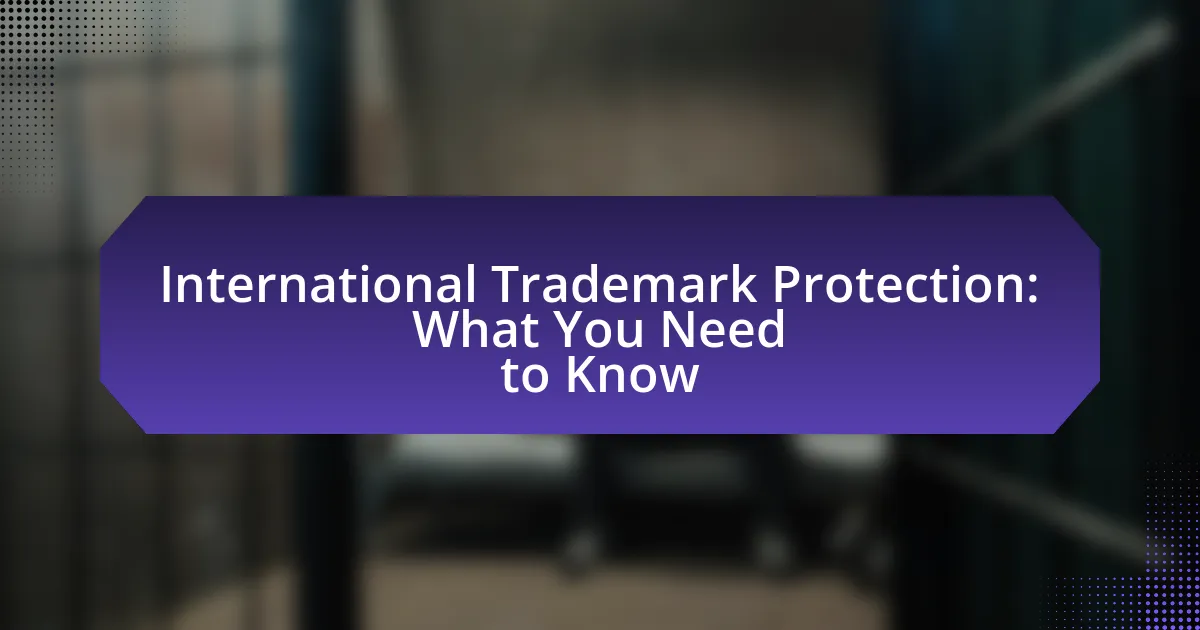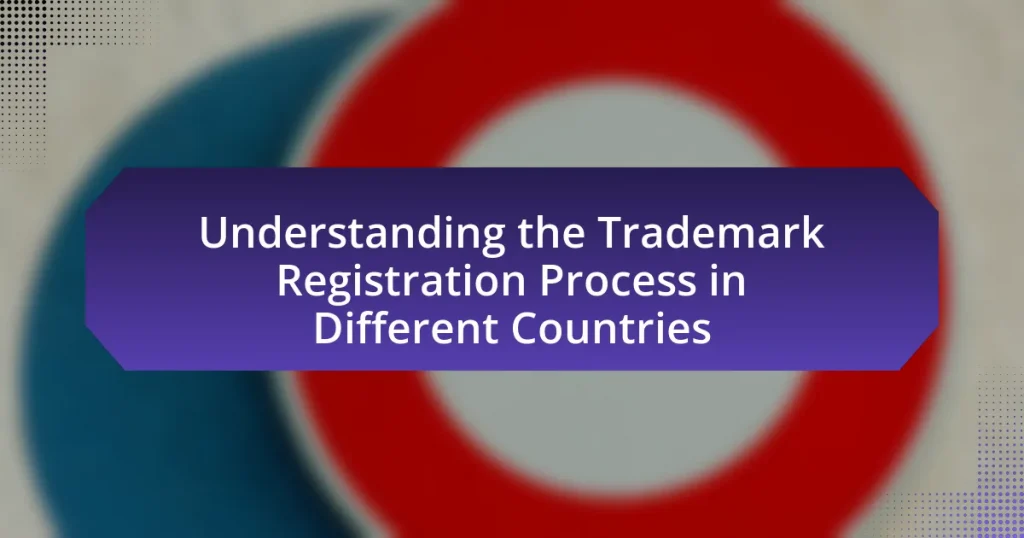International Trademark Protection encompasses the legal frameworks that secure trademarks across various countries, allowing brand owners to prevent unauthorized use of their marks globally. The article outlines the functioning of international trademark protection through treaties like the Madrid Protocol and the Paris Convention, emphasizing key principles such as territoriality, priority, and distinctiveness. It highlights the importance of securing trademarks for businesses to maintain brand integrity and consumer trust, while also addressing the risks of operating without such protection. Additionally, the article discusses the different types of international trademark protection, regional differences, and practical steps businesses can take to navigate the complexities of trademark registration and enforcement in the global marketplace.
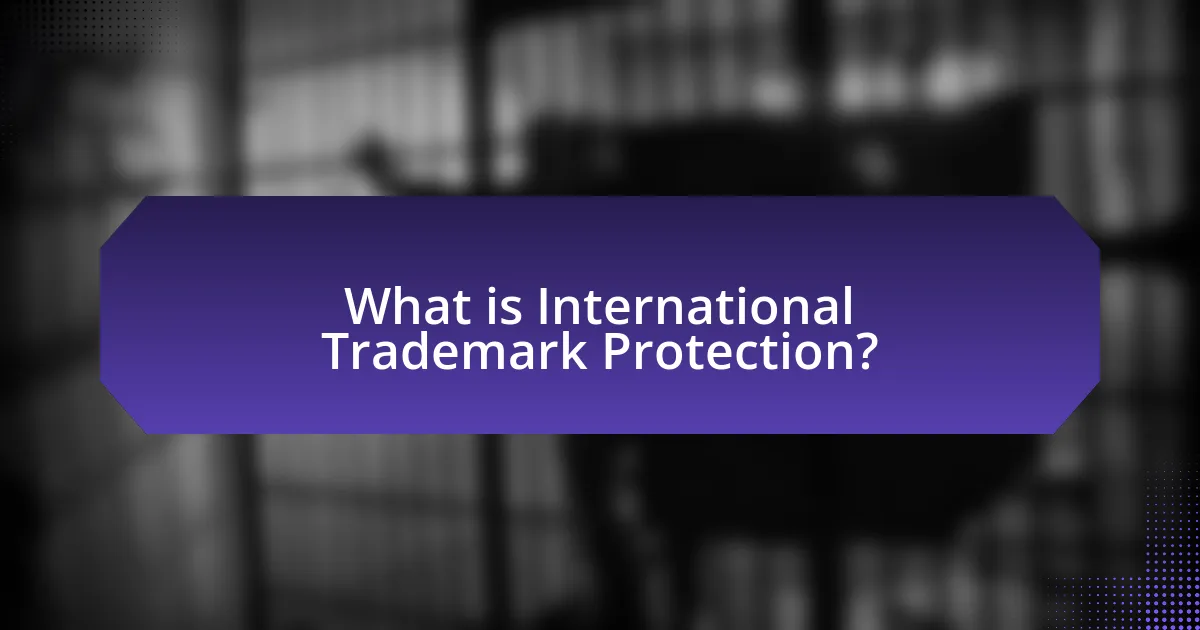
What is International Trademark Protection?
International Trademark Protection refers to the legal mechanisms that safeguard trademarks across multiple countries, ensuring that brand owners can prevent unauthorized use of their marks internationally. This protection is facilitated through treaties such as the Madrid Protocol, which allows trademark owners to register their marks in multiple jurisdictions with a single application, thereby streamlining the process and reducing costs. The significance of international trademark protection is underscored by the fact that global trade continues to expand, making it essential for businesses to secure their intellectual property rights in various markets to maintain brand integrity and consumer trust.
How does International Trademark Protection function globally?
International Trademark Protection functions globally through a combination of international treaties and national laws that facilitate the registration and enforcement of trademarks across borders. The primary framework for this is the Madrid System, administered by the World Intellectual Property Organization (WIPO), which allows trademark owners to register their marks in multiple countries through a single application. Additionally, the Agreement on Trade-Related Aspects of Intellectual Property Rights (TRIPS) sets minimum standards for trademark protection that member countries must adhere to, ensuring a baseline level of protection globally. This system enables businesses to safeguard their brands internationally, reducing the risk of infringement and enhancing market presence.
What are the key principles of International Trademark Protection?
The key principles of International Trademark Protection include territoriality, priority, and distinctiveness. Territoriality means that trademark rights are generally limited to the jurisdiction where the trademark is registered, as established by the Paris Convention for the Protection of Industrial Property. Priority refers to the first-to-file principle, where the first party to register a trademark in a specific country gains the exclusive rights to that mark, supported by the Madrid Protocol. Distinctiveness requires that a trademark must be capable of distinguishing goods or services of one entity from those of others, which is a fundamental requirement in most jurisdictions to ensure consumer recognition and protection against confusion.
How do different countries implement International Trademark Protection?
Different countries implement International Trademark Protection through various legal frameworks and treaties, primarily the Madrid Protocol and the Paris Convention. The Madrid Protocol allows trademark owners to register their marks in multiple countries through a single application, streamlining the process for international protection. For instance, countries like the United States and members of the European Union utilize this system to facilitate trademark registration across borders. The Paris Convention, on the other hand, establishes a baseline for trademark rights, ensuring that member countries provide certain protections to foreign trademark holders, such as the right of priority. Countries like Japan and Brazil adhere to these treaties, enhancing their trademark protection systems. These frameworks collectively enable countries to harmonize their trademark laws and provide a more cohesive international protection mechanism.
Why is International Trademark Protection important for businesses?
International Trademark Protection is crucial for businesses because it safeguards brand identity and prevents unauthorized use of trademarks in global markets. By securing trademarks internationally, businesses can maintain their reputation, ensure consumer trust, and protect their intellectual property from infringement. For instance, according to the World Intellectual Property Organization, businesses that register their trademarks in multiple jurisdictions can significantly reduce the risk of brand dilution and counterfeiting, which can lead to substantial financial losses. This protection fosters a competitive advantage and encourages innovation, as companies are more likely to invest in their brands when they know their trademarks are legally protected across borders.
What risks do businesses face without International Trademark Protection?
Businesses face significant risks without International Trademark Protection, including brand dilution, loss of market share, and legal disputes. Without protection, competitors can use similar trademarks, leading to consumer confusion and undermining brand reputation. A study by the International Trademark Association indicates that 70% of businesses experience brand infringement, which can result in substantial financial losses and damage to customer trust. Additionally, without international protection, businesses may find it challenging to enforce their rights in foreign jurisdictions, exposing them to further risks of unauthorized use and counterfeiting.
How does International Trademark Protection enhance brand value?
International Trademark Protection enhances brand value by safeguarding a company’s intellectual property, which fosters consumer trust and loyalty. When a trademark is protected internationally, it prevents unauthorized use and counterfeiting, ensuring that consumers can reliably identify the source of goods and services. This protection can lead to increased market share and pricing power, as brands with strong trademarks often command higher prices due to perceived quality and reputation. According to a study by the International Trademark Association, brands with registered trademarks can see a valuation increase of up to 20% compared to those without such protections, demonstrating the tangible financial benefits of international trademark registration.
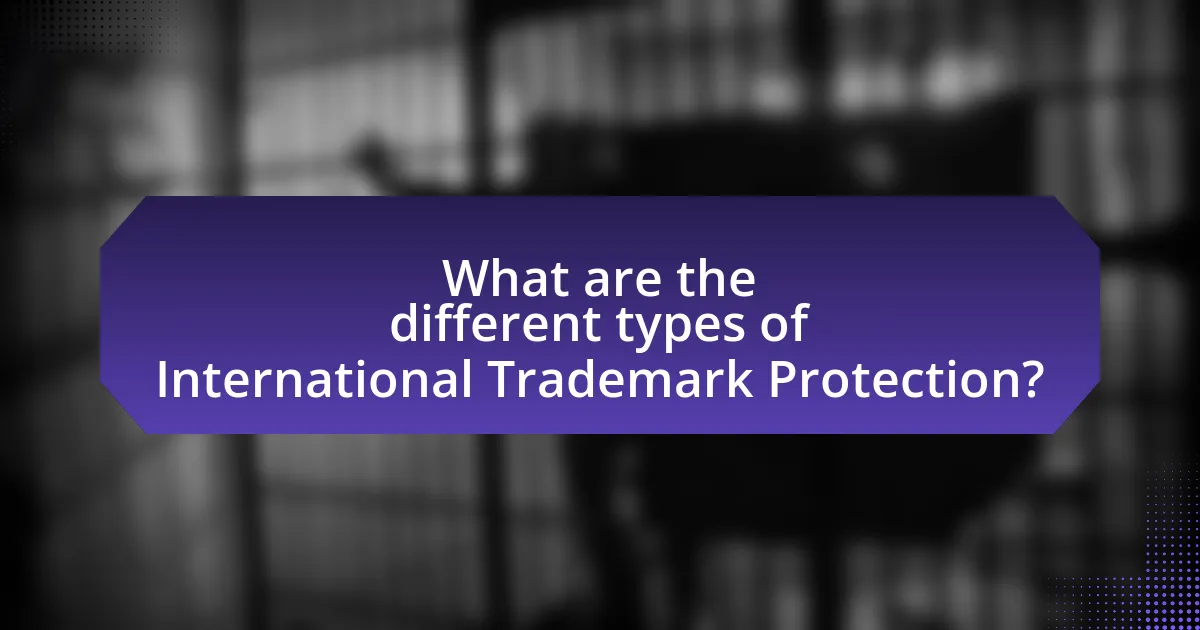
What are the different types of International Trademark Protection?
The different types of International Trademark Protection include national registration, regional registration, and international treaties. National registration involves filing for trademark protection in individual countries, which grants exclusive rights within that specific jurisdiction. Regional registration, such as the European Union Trademark (EUTM), allows for trademark protection across multiple countries within a specific region through a single application. International treaties, like the Madrid Protocol, facilitate the process of obtaining trademark protection in multiple countries by allowing a trademark owner to file one application that can extend to several member countries, streamlining the registration process and reducing costs.
What are the main international treaties governing trademark protection?
The main international treaties governing trademark protection are the Paris Convention for the Protection of Industrial Property, the Agreement on Trade-Related Aspects of Intellectual Property Rights (TRIPS), and the Madrid Protocol. The Paris Convention, established in 1883, provides a framework for protecting industrial property, including trademarks, across member countries. The TRIPS Agreement, which came into force in 1995, sets minimum standards for intellectual property protection, including trademarks, and is part of the World Trade Organization framework. The Madrid Protocol, adopted in 1989, facilitates the international registration of trademarks, allowing trademark owners to seek protection in multiple countries through a single application. These treaties collectively enhance the global protection of trademarks and provide a legal basis for enforcement and dispute resolution.
How does the Madrid Protocol facilitate international trademark registration?
The Madrid Protocol facilitates international trademark registration by allowing trademark owners to file a single application to seek protection in multiple countries. This streamlined process reduces the complexity and cost associated with filing separate applications in each jurisdiction, as it enables applicants to designate multiple member countries in one application. The protocol also provides a centralized system for managing trademark registrations, making it easier for businesses to maintain and renew their trademarks across different territories. As of October 2023, the Madrid System includes over 100 member countries, significantly enhancing the global reach of trademark protection for businesses.
What role does the Paris Convention play in trademark protection?
The Paris Convention establishes a foundational framework for international trademark protection by ensuring that member countries provide a minimum standard of protection for trademarks. This treaty, adopted in 1883, allows trademark owners to file for protection in multiple countries while maintaining their priority rights, meaning that if a trademark is registered in one member country, the owner can claim the same filing date in other member countries within a specified period. This priority system is crucial for protecting trademarks globally, as it helps prevent conflicts and ensures that businesses can secure their brand identity across borders.
What are the regional differences in International Trademark Protection?
Regional differences in International Trademark Protection primarily manifest in the legal frameworks, enforcement mechanisms, and registration processes across various jurisdictions. For instance, the United States follows a “first-to-use” system, granting rights based on actual use of the trademark, while many countries, including those in Europe, operate under a “first-to-file” system, where rights are granted based on the filing date. Additionally, enforcement varies significantly; the European Union has a unified trademark system allowing for cross-border protection, whereas countries like India have a more fragmented approach, requiring separate registrations in different states. These differences impact how businesses strategize their trademark protection globally, necessitating tailored approaches based on regional laws and practices.
How does trademark protection differ between the EU and the US?
Trademark protection in the EU is based on a “first to file” system, while the US operates under a “first to use” principle. In the EU, trademark rights are acquired through registration, and the European Union Intellectual Property Office (EUIPO) oversees this process, allowing for a unified trademark system across member states. Conversely, in the US, trademark rights can be established through actual use in commerce, and the United States Patent and Trademark Office (USPTO) primarily handles registrations. This fundamental difference affects how trademarks are enforced and the scope of protection available in each jurisdiction.
What unique challenges do businesses face in emerging markets?
Businesses in emerging markets face unique challenges such as regulatory instability, inadequate infrastructure, and cultural differences. Regulatory instability can lead to unpredictable changes in laws and policies, making it difficult for businesses to plan long-term strategies. Inadequate infrastructure, including transportation and communication systems, hampers operational efficiency and increases costs. Cultural differences can create misunderstandings in marketing and customer engagement, impacting brand perception and acceptance. According to the World Bank, countries classified as emerging markets often have lower ease of doing business rankings, which reflects these challenges and their impact on foreign investment and local entrepreneurship.
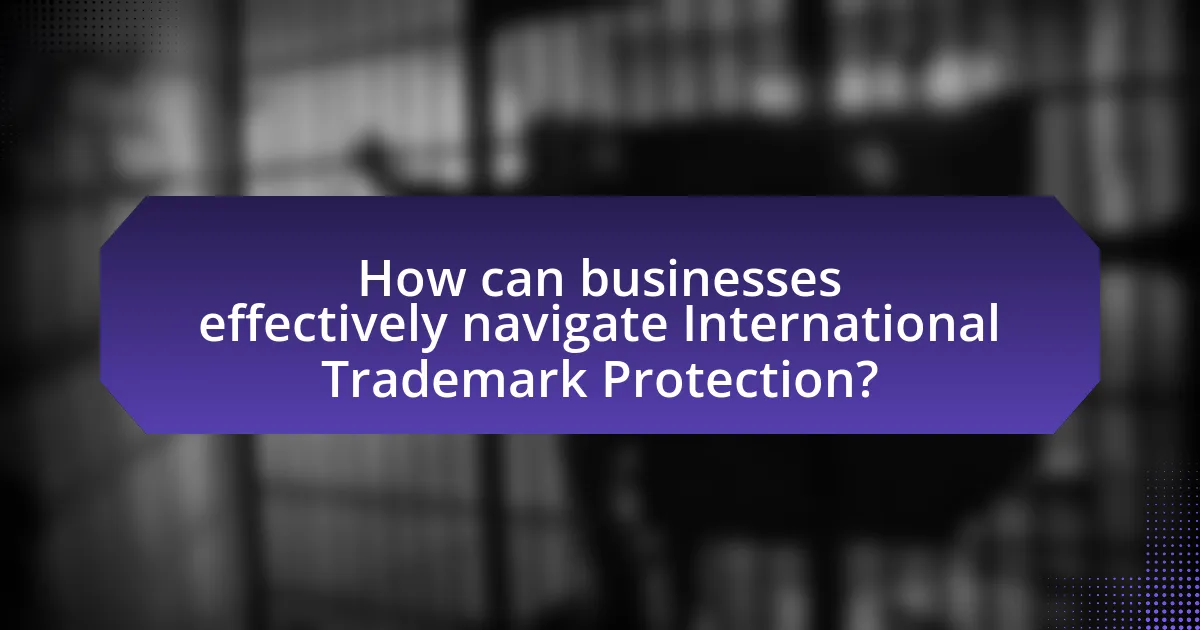
How can businesses effectively navigate International Trademark Protection?
Businesses can effectively navigate International Trademark Protection by conducting thorough research on trademark laws in each target country and registering their trademarks in those jurisdictions. This approach ensures that businesses understand the specific requirements and processes for trademark registration, which can vary significantly across different countries. For instance, the Madrid Protocol allows businesses to file a single application for trademark protection in multiple countries, streamlining the process and reducing costs. Additionally, businesses should monitor their trademarks for potential infringements and enforce their rights through legal channels when necessary, as proactive enforcement is crucial for maintaining trademark integrity.
What steps should businesses take to secure their trademarks internationally?
Businesses should register their trademarks in each country where they operate or plan to operate. This involves conducting a comprehensive trademark search to ensure the desired mark is available and not already in use. Following this, businesses must file applications with the relevant national trademark offices or utilize international systems like the Madrid Protocol, which allows for the registration of trademarks in multiple jurisdictions through a single application. Additionally, businesses should monitor their trademarks for potential infringements and enforce their rights through legal action if necessary. According to the World Intellectual Property Organization, over 1.5 million international trademark applications were filed in 2021, highlighting the importance of securing trademarks globally.
How can businesses conduct a trademark search before registration?
Businesses can conduct a trademark search before registration by utilizing online databases and resources to check for existing trademarks. The United States Patent and Trademark Office (USPTO) provides a searchable database called the Trademark Electronic Search System (TESS), which allows users to search for registered trademarks and pending applications. Additionally, businesses can use international databases such as the World Intellectual Property Organization (WIPO) Global Brand Database to check for trademarks in multiple jurisdictions. Conducting a thorough search helps identify potential conflicts and ensures that the desired trademark is available for use and registration.
What are the best practices for filing international trademark applications?
The best practices for filing international trademark applications include conducting thorough trademark searches, selecting the appropriate filing strategy, and ensuring compliance with local laws. Conducting comprehensive searches helps identify potential conflicts with existing trademarks, reducing the risk of rejection. Choosing the right filing strategy, such as using the Madrid Protocol for multiple jurisdictions, streamlines the application process and can save costs. Additionally, understanding and adhering to the specific requirements of each country, including language and documentation, is crucial for successful registration. These practices are supported by the World Intellectual Property Organization (WIPO), which emphasizes the importance of careful planning and research in the trademark application process.
What common pitfalls should businesses avoid in International Trademark Protection?
Businesses should avoid the common pitfalls of inadequate research, failure to register trademarks in all relevant jurisdictions, neglecting to monitor and enforce trademark rights, and overlooking local laws and cultural differences. Inadequate research can lead to conflicts with existing trademarks, while failing to register in all relevant jurisdictions can result in loss of rights in key markets. Neglecting to monitor and enforce trademark rights can allow competitors to infringe on those rights, diminishing brand value. Additionally, overlooking local laws and cultural differences can lead to trademark applications being rejected or misinterpreted, as seen in cases where brands have faced backlash due to cultural insensitivity.
How can businesses prevent trademark infringement in foreign markets?
Businesses can prevent trademark infringement in foreign markets by conducting thorough trademark searches and registering their trademarks in each target country. Conducting trademark searches helps identify existing trademarks that may conflict with the business’s brand, reducing the risk of unintentional infringement. Registering trademarks in foreign jurisdictions provides legal protection and exclusive rights to use the mark, as evidenced by the fact that countries that are members of the Madrid Protocol allow for international trademark registration, streamlining the process for businesses. Additionally, businesses should monitor the market for potential infringements and enforce their rights through legal action when necessary, as proactive enforcement can deter infringers and protect brand integrity.
What are the consequences of failing to renew international trademarks?
Failing to renew international trademarks results in the loss of trademark protection, allowing others to use the mark without permission. This can lead to brand dilution, loss of market share, and potential legal disputes as competitors may exploit the unprotected trademark. Additionally, the original owner may face challenges in re-establishing rights to the trademark, as it may become available for registration by other parties. The consequences underscore the importance of timely renewal to maintain exclusive rights and brand integrity in the global marketplace.
What practical tips can help businesses manage their international trademarks?
To effectively manage international trademarks, businesses should conduct thorough research on trademark laws in each target country. This involves understanding the specific registration processes, potential conflicts, and enforcement mechanisms unique to each jurisdiction. Additionally, businesses should maintain a comprehensive trademark portfolio that includes regular monitoring for potential infringements and renewals to ensure ongoing protection. Utilizing international treaties, such as the Madrid Protocol, can streamline the registration process across multiple countries, making it easier to manage trademarks globally. Regular audits of trademark usage and compliance with local laws further enhance protection and reduce the risk of disputes.
